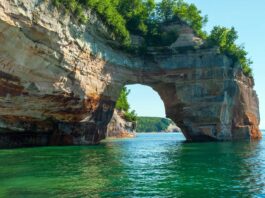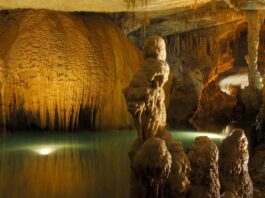Durdle Door is a natural limestone arch located along the Jurassic Coast in Dorset, England. It is one of the most iconic and recognizable landmarks in the country and attracts thousands of visitors each year. The name “Durdle Door” is derived from the Old English word “thirl,” meaning bore or drill, and the Middle English word “dure,” meaning door or gate, referring to the arch’s unique shape.



The formation of Durdle Door began around 140 million years ago during the Jurassic period when the area was covered by a warm, shallow sea. Over time, layers of sediment and debris accumulated, and through the process of geological folding, the rocks were uplifted and tilted. Erosion from the sea gradually wore away the weaker rock layers, leaving behind the more resistant limestone that formed the arch.
The arch itself stands about 200 feet (60 meters) high and spans approximately 100 feet (30 meters) wide. Its distinctive shape is a result of differential erosion, with the waves eroding the softer rocks surrounding the limestone arch. The arch is part of the larger Lulworth Cove and Durdle Door Natural World Heritage Site, recognized for its geological significance and natural beauty.
Durdle Door is not only admired for its geological features but also for its stunning coastal scenery. The area offers breathtaking views of the English Channel and the Jurassic Coast, which is renowned for its diverse geology and fossil-rich cliffs. Visitors can enjoy walking along the coastal paths, exploring nearby beaches, and taking in the panoramic vistas from the top of the cliffs.
The site is popular for various outdoor activities, including swimming, sunbathing, picnicking, and photography. The clear turquoise waters below the arch make it a favorite spot for swimming, although visitors should be cautious of strong currents and changing tides. Durdle Door has also become a popular destination for filmmakers and photographers, featuring in several movies and TV shows.
To access Durdle Door, there is a car park located a short distance away, from which a scenic path leads down to the beach and the arch. The area can get quite busy during peak tourist seasons, so it’s advisable to arrive early or visit during quieter times to fully appreciate the natural beauty and tranquility of this remarkable landmark.
Durdle Door is not only a geological wonder but also a place of natural beauty and historical significance, offering visitors a unique experience along the enchanting Jurassic Coast.
Contents
Geology of Durdle Door
The geology of Durdle Door is closely tied to the formation of the Jurassic Coast, a UNESCO World Heritage Site known for its exceptional geological features and fossil record. Durdle Door itself is a result of complex geological processes that occurred over millions of years.
Durdle Door is situated within the Lulworth Formation, which is part of the larger Purbeck Group. These rock formations date back to the late Jurassic period, approximately 140 million years ago. During this time, the area was covered by a shallow, warm sea, and layers of sediment, including limestone, were deposited over millions of years.
The formation of Durdle Door began with the gradual deposition of sediment, primarily consisting of clay, silt, and sand, which formed layers of softer rock. These layers were later compressed and hardened over time, transforming into the limestone that we see today. The limestone is mainly composed of calcium carbonate, derived from the remains of marine organisms such as shells and corals.
Around 70 million years ago, tectonic forces began to shape the area. The Earth’s crust experienced folding and uplifting, resulting in the formation of a dome-like structure known as the Lulworth anticline. This folding process caused the layers of rock to tilt, exposing them to the forces of erosion.
Subsequent erosion by the sea played a crucial role in shaping Durdle Door. The relentless pounding of waves against the coastline gradually wore away the softer rocks surrounding the limestone arch. Over time, this differential erosion created a distinctive, freestanding arch.
The limestone arch of Durdle Door is composed of a more resistant layer of rock known as Portland Limestone, which is harder than the surrounding rocks. This resilient layer has been able to withstand erosion better than the softer rock layers, resulting in the formation of the arch.
It is important to note that the ongoing processes of erosion and weathering continue to shape the Durdle Door area. While the limestone arch itself is relatively stable, the cliffs and coastline are subject to ongoing erosion, which leads to the retreat of the coastline and the formation of new geological features.
The geology of Durdle Door and the wider Jurassic Coast is of significant scientific importance. The area provides a window into the Earth’s history, with its distinct rock layers and rich fossil record, offering valuable insights into the ancient marine environments and the evolution of life on our planet.
Natural Environment
Durdle Door is set within a stunning natural environment, known as the Jurassic Coast, which encompasses a stretch of coastline in Dorset, England. This area is renowned for its outstanding natural beauty, unique geological features, diverse ecosystems, and rich biodiversity.
The coastal landscape around Durdle Door is characterized by towering cliffs, rocky outcrops, and secluded coves. The white limestone cliffs provide a striking contrast against the blue waters of the English Channel, creating a picturesque scene. These cliffs are subject to ongoing erosion by the sea, resulting in the constant reshaping of the coastline.
The surrounding area is home to a variety of habitats, including chalk grasslands, woodlands, heathlands, and intertidal zones. These habitats support a diverse range of plant and animal species. The cliffs provide nesting sites for seabirds such as guillemots, fulmars, and peregrine falcons, while the nearby woodlands and grasslands attract woodland birds, butterflies, and other insects.
The marine environment along the Jurassic Coast is also teeming with life. The clear turquoise waters around Durdle Door harbor various marine species, including fish, crabs, lobsters, and a variety of marine invertebrates. The intertidal zones are rich in rock pool creatures, such as anemones, crabs, and small fish, which thrive in the shallow pools left behind by the receding tide.
The Jurassic Coast is not only visually captivating but also holds significant scientific value. The area’s geological formations and fossil record provide valuable insights into Earth’s history, documenting millions of years of geological processes and the evolution of life. Fossils, including ammonites, belemnites, and marine reptiles, can be found embedded in the cliffs, offering a glimpse into prehistoric marine ecosystems.
Conservation efforts are in place to protect the natural environment surrounding Durdle Door and the Jurassic Coast. The area is designated as a World Heritage Site, recognizing its geological importance and unique natural features. Conservation initiatives focus on preserving the diverse habitats, safeguarding vulnerable species, and promoting sustainable tourism practices to minimize the impact on the environment.
Visitors to Durdle Door can enjoy the beauty of the natural environment by exploring the coastal paths, taking in the panoramic views, and immersing themselves in the tranquility of the surroundings. It is essential to respect and appreciate the fragile ecosystems and follow responsible practices to ensure the preservation of this remarkable natural environment for future generations.
Durdle Door Beach
Durdle Door Beach is a beautiful sandy beach located at the base of the iconic Durdle Door limestone arch along the Jurassic Coast in Dorset, England. The beach is nestled within a sheltered cove, providing a picturesque setting for visitors to enjoy.
The beach is accessed by a steep path leading down from the cliff tops, offering stunning views of the arch and the surrounding coastline along the way. The descent can be challenging for some, but the breathtaking scenery and the allure of the beach make it well worth the effort.
Durdle Door Beach is known for its crystal-clear turquoise waters, which are perfect for swimming and snorkeling. The sheltered cove provides a relatively calm and safe swimming environment, although caution should always be exercised, especially with changing tides and currents. It is advisable to check local tide times and be aware of any safety warnings.
The sandy shoreline stretches out in front of the arch, providing ample space for sunbathing, picnicking, and beach games. Visitors can relax on the soft sand, soak up the sun, and take in the magnificent views of the limestone cliffs and the arch itself. It’s a great spot to unwind, enjoy a picnic with family and friends, or simply take a leisurely stroll along the shore.
During low tide, it is possible to explore the rock pools and discover various marine creatures, such as small fish, crabs, and sea anemones. These intertidal areas offer an opportunity for nature enthusiasts, particularly children, to observe and learn about the fascinating marine life.
It is important to note that Durdle Door Beach is a natural and relatively unspoiled environment, so visitors are encouraged to practice responsible tourism and respect the area’s beauty and fragile ecosystems. Litter should be properly disposed of, and any wildlife should be observed from a respectful distance to avoid disturbance.
The popularity of Durdle Door Beach means that it can get quite busy, especially during the summer months and weekends. To enjoy a quieter experience, it is advisable to visit during weekdays or during the off-peak seasons. Additionally, facilities such as toilets, refreshment stands, and parking are available nearby to enhance visitors’ convenience.
Durdle Door Beach offers a captivating combination of natural beauty, stunning coastal views, and the opportunity to relax and enjoy the beach in a truly remarkable setting. Whether you’re seeking adventure in the water or a tranquil day on the sand, Durdle Door Beach is a must-visit destination for beach lovers and nature enthusiasts alike.
Tourism and Visitor Information
Tourism and visitor information for Durdle Door:
- Best Time to Visit: Durdle Door can be visited throughout the year, but the summer months (June to August) are the busiest. If you prefer a quieter experience, consider visiting during the shoulder seasons of spring (April to May) or autumn (September to October).
- Weather: The weather in Dorset can vary, so it’s advisable to check the forecast before your visit. Pack appropriate clothing, sunscreen, and be prepared for changing weather conditions, especially if you plan to spend time on the beach or walking along the coastal paths.
- Accessibility: Durdle Door is accessible by car and public transportation. There is a car park located a short distance from the site, but it can fill up quickly during peak times. Alternatively, you can take a bus to the nearby village of West Lulworth and walk to Durdle Door from there.
- Walking and Hiking: Durdle Door offers several scenic coastal paths for walkers and hikers to explore the area. The South West Coast Path runs along the cliffs, providing breathtaking views of the coastline. It is advisable to wear comfortable footwear and be mindful of the rugged terrain.
- Safety: When visiting Durdle Door, it is essential to prioritize safety. The cliffs and rocky areas can be unstable, so it’s important to stay on designated paths and avoid climbing on the cliffs or arch itself. When swimming, be aware of tides and currents, and only enter the water if you are a confident swimmer.
- Facilities: There are public toilets located near the car park, as well as refreshment stands offering food and drinks. It is advisable to bring your own water and snacks, especially if you plan to spend an extended period at the beach.
- Photography: Durdle Door is a popular spot for photographers due to its stunning beauty. Capture the arch from different angles and experiment with lighting, but always be aware of your surroundings and respect other visitors’ privacy.
- Nearby Attractions: Durdle Door is located along the Jurassic Coast, offering a range of nearby attractions to explore. Lulworth Cove, a horseshoe-shaped bay with clear waters, is within walking distance. Other notable sites include the Old Harry Rocks, Corfe Castle, and the charming town of Swanage.
FAQs
How did Durdle Door get its name?
The name “Durdle Door” comes from the Old English word “thirl,” meaning bore or drill, and the Middle English word “dure,” meaning door or gate, referring to the arch’s unique shape.
Can you swim at Durdle Door Beach?
Yes, swimming is allowed at Durdle Door Beach. However, it’s important to be cautious of strong currents and changing tides. It is advisable to assess the conditions and your swimming abilities before entering the water.
Is Durdle Door suitable for children and families?
Durdle Door is a popular destination for families. Children can enjoy exploring the beach, playing in the sand, and swimming in the calm waters under proper supervision.
Are there any facilities such as toilets and parking available?
Yes, there are public toilets located near the car park. Additionally, there is a car park available, but it can fill up quickly during peak tourist seasons. It is advisable to arrive early or consider alternative transportation options.
Are there any food and drink options available at Durdle Door?
Yes, there are refreshment stands near the car park where you can find food and drinks. However, it’s a good idea to bring your own water and snacks, especially if you plan to spend an extended period at the beach.
Can you go camping at Durdle Door?
Camping is not permitted at Durdle Door Beach or in the immediate vicinity. However, there are nearby campgrounds and accommodations available if you wish to stay overnight in the area.
Are dogs allowed at Durdle Door Beach?
Dogs are permitted at Durdle Door Beach but must be kept on a leash. It’s important to clean up after your pet and be considerate of other visitors.
Can you access the top of the arch?
No, it is not possible to access the top of the arch. Climbing on the arch or the cliffs is strictly prohibited due to safety concerns and the need to preserve the natural environment.
Are there any restrictions for photography at Durdle Door?
Photography is allowed and encouraged at Durdle Door. However, it’s important to be mindful of your surroundings, respect other visitors’ privacy, and follow any guidelines or restrictions in place.
Can you visit Durdle Door during the winter months?
Yes, Durdle Door can be visited during the winter months. The site offers beautiful coastal views and a peaceful atmosphere. However, weather conditions can be cold and unpredictable, so it’s advisable to dress accordingly and check the forecast before your visit.






